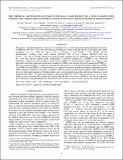| dc.contributor.author | Hollek, Julie K. | |
| dc.contributor.author | Placco, Vinicius M. | |
| dc.contributor.author | Karakas, Amanda I. | |
| dc.contributor.author | Shetrone, Matthew | |
| dc.contributor.author | Sneden, Christopher | |
| dc.contributor.author | Christlieb, Norbert | |
| dc.contributor.author | Frebel, Anna L. | |
| dc.date.accessioned | 2016-01-04T17:49:53Z | |
| dc.date.available | 2016-01-04T17:49:53Z | |
| dc.date.issued | 2015-11 | |
| dc.date.submitted | 2013-11 | |
| dc.identifier.issn | 1538-4357 | |
| dc.identifier.issn | 0004-637X | |
| dc.identifier.uri | http://hdl.handle.net/1721.1/100583 | |
| dc.description.abstract | We present a detailed abundance analysis of 23 elements for a newly discovered carbon-enhanced metal-poor (CEMP) star, HE 0414−0343, from the Chemical Abundances of Stars in the Halo Project. Its spectroscopic stellar parameters are T[subscript eff] = 4863 K, log g = 1.25, ξ = 2.20 km s[superscript −1], and [Fe/H] = −2.24. Radial velocity measurements covering seven years indicate HE 0414−0343 to be a binary. HE 0414−0343 has [C/Fe] = 1.44 and is strongly enhanced in neutron-capture elements but its abundances cannot be reproduced by a solar-type s-process pattern alone. Traditionally, it could be classified as a "CEMP-r/s" star. Based on abundance comparisons with asymptotic giant branch (AGB) star nucleosynthesis models, we suggest a new physically motivated origin and classification scheme for CEMP-s stars and the still poorly understood CEMP-r/s. The new scheme describes a continuous transition between these two so-far distinctly treated subgroups: CEMP-sA, CEMP-sB, and CEMP-sC. Possible causes for a continuous transition include the number of thermal pulses the AGB companion underwent, the effect of different AGB star masses on their nucleosynthetic yields, and physics that is not well approximated in 1D stellar models such as proton ingestion episodes and rotation. Based on a set of detailed AGB models, we suggest the abundance signature of HE 0414−0343 to have arisen from a >1.3 M[subscript ⊙] mass AGB star and a late-time mass transfer that transformed HE 0414−0343 into a CEMP-sC star. We also find that the [Y/Ba] ratio well parametrizes the classification and can thus be used to easily classify any future such stars. | en_US |
| dc.description.sponsorship | National Science Foundation (U.S.) (Grant AST-1255160) | en_US |
| dc.language.iso | en_US | |
| dc.publisher | IOP Publishing | en_US |
| dc.relation.isversionof | http://dx.doi.org/10.1088/0004-637x/814/2/121 | en_US |
| dc.rights | Article is made available in accordance with the publisher's policy and may be subject to US copyright law. Please refer to the publisher's site for terms of use. | en_US |
| dc.source | IOP Publishing | en_US |
| dc.title | THE CHEMICAL ABUNDANCES OF STARS IN THE HALO (CASH) PROJECT. III. A NEW CLASSIFICATION SCHEME FOR CARBON-ENHANCED METAL-POOR STARS WITH s-PROCESS ELEMENT ENHANCEMENT | en_US |
| dc.type | Article | en_US |
| dc.identifier.citation | Hollek, Julie K., Anna Frebel, Vinicius M. Placco, Amanda I. Karakas, Matthew Shetrone, Christopher Sneden, and Norbert Christlieb. “THE CHEMICAL ABUNDANCES OF STARS IN THE HALO (CASH) PROJECT. III. A NEW CLASSIFICATION SCHEME FOR CARBON-ENHANCED METAL-POOR STARS WITH s-PROCESS ELEMENT ENHANCEMENT.” The Astrophysical Journal 814, no. 2 (November 25, 2015): 121. © 2015 The American Astronomical Society | en_US |
| dc.contributor.department | Massachusetts Institute of Technology. Department of Physics | en_US |
| dc.contributor.department | MIT Kavli Institute for Astrophysics and Space Research | en_US |
| dc.contributor.mitauthor | Frebel, Anna L. | en_US |
| dc.relation.journal | The Astrophysical Journal | en_US |
| dc.eprint.version | Final published version | en_US |
| dc.type.uri | http://purl.org/eprint/type/JournalArticle | en_US |
| eprint.status | http://purl.org/eprint/status/PeerReviewed | en_US |
| dspace.orderedauthors | Hollek, Julie K.; Frebel, Anna; Placco, Vinicius M.; Karakas, Amanda I.; Shetrone, Matthew; Sneden, Christopher; Christlieb, Norbert | en_US |
| dc.identifier.orcid | https://orcid.org/0000-0002-2139-7145 | |
| mit.license | PUBLISHER_POLICY | en_US |
| mit.metadata.status | Complete | |
